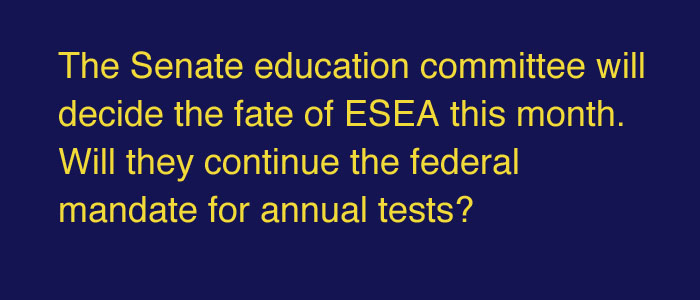ESEA Reauthorization Under Way: Keep the Pressure on Congress!

By Monty Neill and Lisa Guisbond.
The draft rewrite of No Child Left Behind that the Senate education committee will debate on April 14 –“Every Child Achieves” (link here) – fails to reduce the law’s deeply destructive annual testing mandate. It keeps the requirement to test every child in every year in reading and math in grades 3-8.
Test reformers still have the opportunity to win testing cutbacks, either in committee or when the bill goes to the Senate floor, which could happen as early as the last week of April. FairTest is among many groups that support a rollback to once each in elementary and middle school, in addition to once in high school as is now the case. (Science is already tested that way.)
To win, we must keep up the pressure. Last week, people sent thousands of emails to their Senators, made phone calls and launched a twitter storm. You can still call or email:
You can find your Senator’s phone number by clicking here.
To send an email, go to this page at FairTest (link here.)
NCLB, the current version of the Elementary and Secondary Education Act (ESEA), significantly harmed public education, especially for vulnerable students. This is primarily because of two flawed components: mandated annual testing in reading and math in grades 3-8, plus once in high school; and the punitive sanctions attached to those tests. The consequences include narrowed curriculum, teaching to the test, increased cheating, a wider school-to-prison pipeline, emotional damage to children, and school closings in low-income neighborhoods.
The Senate committee bill would allow use of performance assessments as one part of a system. Performance assessments include portfolios, projects and extended tasks, such as research papers and lab experiments. Well-designed and implemented performance assessments promote in-depth, engaging instruction with powerful outcomes for students. However, their positive impact is limited in the context of a test-driven system. Without addressing the problem of testing in every grade every year, therefore, this rewrite would perpetuate an educationally damaging system.
The bill would create an “innovation” program, through which up to five states can apply in the new law’s first three years. It would allow states to build systems focused on portfolios and projects that could replace statewide exams for accountability purposes. The systems could include locally-designed assessments that vary across schools and districts but still produce comparable results across the state.
While creating the new assessments, participating districts would not have to use the state test. The best current example is the New York Performance Standards Consortium, a network of 48 public high schools. They require students to successfully complete extended tasks in four subjects to graduate, while the state exempts students from all but one of five graduation exams. Consortium schools have produced far better outcomes for their students than traditional city high schools, including higher high school graduation and college persistence rates. For more information, visit their web site here.
The proposed implementation requirements, however, are too stringent. For example, they say the new assessments must be “equivalent” to current tests. That implies a requirement to measure only the same things the tests do, which would undermine the advantages of performance assessments, such as tapping a broader range of skills or assessing knowledge in more depth. Advocates are pushing to ensure this proposal is workable for states by authorizing greater flexibility. While a reduction in mandated tests is essential, the innovation program could facilitate transition to superior assessment systems.
There are other testing-related problems with the bill. It includes a voluntary “incentive” program for educators in states that apply which requires the use of “merit pay” based on student test scores. A great deal of evidence shows such programs have not improved educational outcomes or school quality (see asummary of research here.)
The good news in “Every Child Achieves” is that it removes the federal sanctions required by NCLB and the highly restrict “waivers” Arne Duncan allowed under the law, all of which have failed to promote educational improvement or equity. Gone are:
- adequate yearly progress (AYP), which requires schools to make impossible gains every year to avoid sanctions;
- all the NCLB and waiver sanctions, from transporting students to other schools to firing staff, closing or privatizing schools; and
- the waiver requirement to implement a teacher and principal evaluation system that included “in significant part” student test score gains (“growth”).
Instead, states will develop plans for how to identify schools that need “support” and “intervene” as needed to assist them. States can use multiple indicators that include student test scores and high school graduation rates, plus other factors from a list the bill provides or that the state wants to consider, and weight them all as they choose. For identified schools, states will have to monitor progress and intervene as needed. In short, accountability is now a state matter with very broad federal requirements.
This does not mean states will automatically overhaul their testing policies. They may, for example, retain sanctions for exam results or judge educators by student test scores. Real assessment reform will require grassroots political action to educate, persuade and pressure state officials to sharply reduce testing, end punitive approaches and improve educational opportunities for all children.
– Monty Neill is Executive Director of FairTest, where Lisa Guisbond it Assessment Reform Analyst.http://www.fairtest.org
